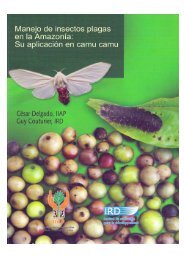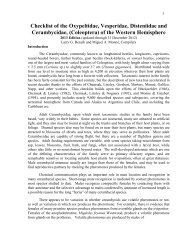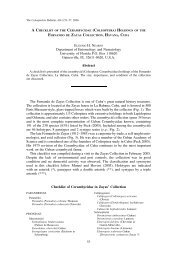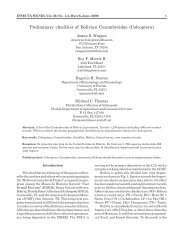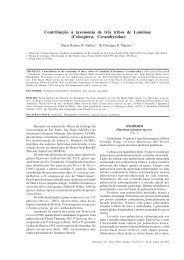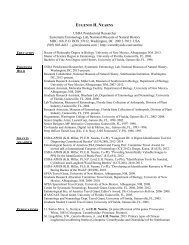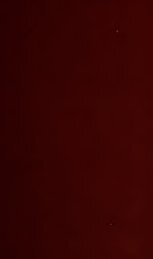You also want an ePaper? Increase the reach of your titles
YUMPU automatically turns print PDFs into web optimized ePapers that Google loves.
180 THE TRIBE ONCIDERINI<br />
tinctly and broadly margined with pale grayish-yellow. Body beneath dark-brown,<br />
rather thinly clothed with fulvous-gray pubescence; abdominal sternites laterally<br />
indistinctly maculate with denser pubescence. Legs piceous, rather thinly covered<br />
with dark brown and iulvous-gray variegated pubescence. Antennae piceous, scape<br />
black; entirely thinly clothed with brown pubescence, with scattered single white<br />
hairs on scape and third segment; all segments beginning with third whitish annu<br />
late at least all lower surface of bases.<br />
Head above with a median impressed line from occiput to epistoma; front con<br />
cave between antennal tubercles, finely, densely punctate, with large, scattered punc<br />
tures interspersed; genae feebly vertical, very finely, densely punctate, with scat<br />
tered, coarse punctures; eye with lower lobe ovate, onc and two-thirds times as high<br />
as gena; antennal tubercles rather well separated, prominent, feebly produced at<br />
apex. Pronotum transverse ; sides arcuate, narrowed to apex, with a feeble tu<br />
bercle behind middle, which is armed at apex with an obtuse process; one apical<br />
and two basal transvere sulci, iI1Iler of which is shallow and broad, extended ob<br />
liquely over latcral tubercles; disk at middle before base with a broad, feebly ele<br />
vated tumescence, each side of middle two otlier feeble, elongate, tumid areas, placed<br />
transversely, the two basal lateral tumid areas coarsely, deeply punctate as are the<br />
bases of the lateral tubercles. Scutellum transverse, sides straight, oblique, apex<br />
subtruncate. Elytra feebly tapering to apices, which are separately broadly<br />
rounded; basal third finely, densely granulate-punctate, these punctures sometimes<br />
confluent and forming transverse rugosities, laterally behind humeri coarsely rugose,<br />
rcmaindcr of disk with a few coarse punctures ; humeri scarcely prominent, posterior<br />
angle with a modcrate-sized tubercle. Prosternum widened behind. Procoxae<br />
prominent, with a feebly raised, subacute tubercle ; profemora somewhat abruptly<br />
elavato after bas.'l.i third, fillCly, transvcrsely rugose on basal' two-thirds of posterior<br />
face, and slightly so on anterior. Fifth stcrnite one-balf longer than fourth, apex<br />
rounded, and with a feebly impressed median line, expanded triangularly apically.<br />
Antennae slightly longer -than body, fimbriate sparsely on scape and fifth segment,<br />
more strongly on third and fourth; scape somcwhat abruptly clavate after basal<br />
third, moderately grooved at base, rest of surface very finely punctate; third seg<br />
ment longer than scape, feebly arcuate, rest gradually shorter.<br />
LENGTH 25-26 mm.; width 9-9.5 mm.<br />
Holotype.-Female ; Barro Colorado, Canal Zone, December,<br />
1930 ; (Griswold) ; [M.C.Z.].<br />
Paratype.-Female ; topotypic ; [M.C.Z. J.<br />
Tybalmia coeca Bates<br />
PLATE VII, FIGURE 15.<br />
Tybalmia coeca Bate.';', Trans. Ent. Soc. Lond., 1872, p. 201.<br />
rl'he V-shaped macula at the middle of each elytron, the bisin<br />
uate third segment of antennae, and unitubel'culate humeri will<br />
serve to distinguish this species.



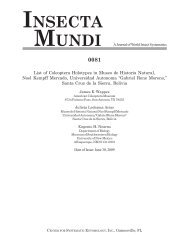
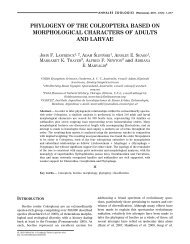


![Coleoptera. Vol. I. [Longicornia. Part I.]](https://img.yumpu.com/41202793/1/180x260/coleoptera-vol-i-longicornia-part-i.jpg?quality=85)
